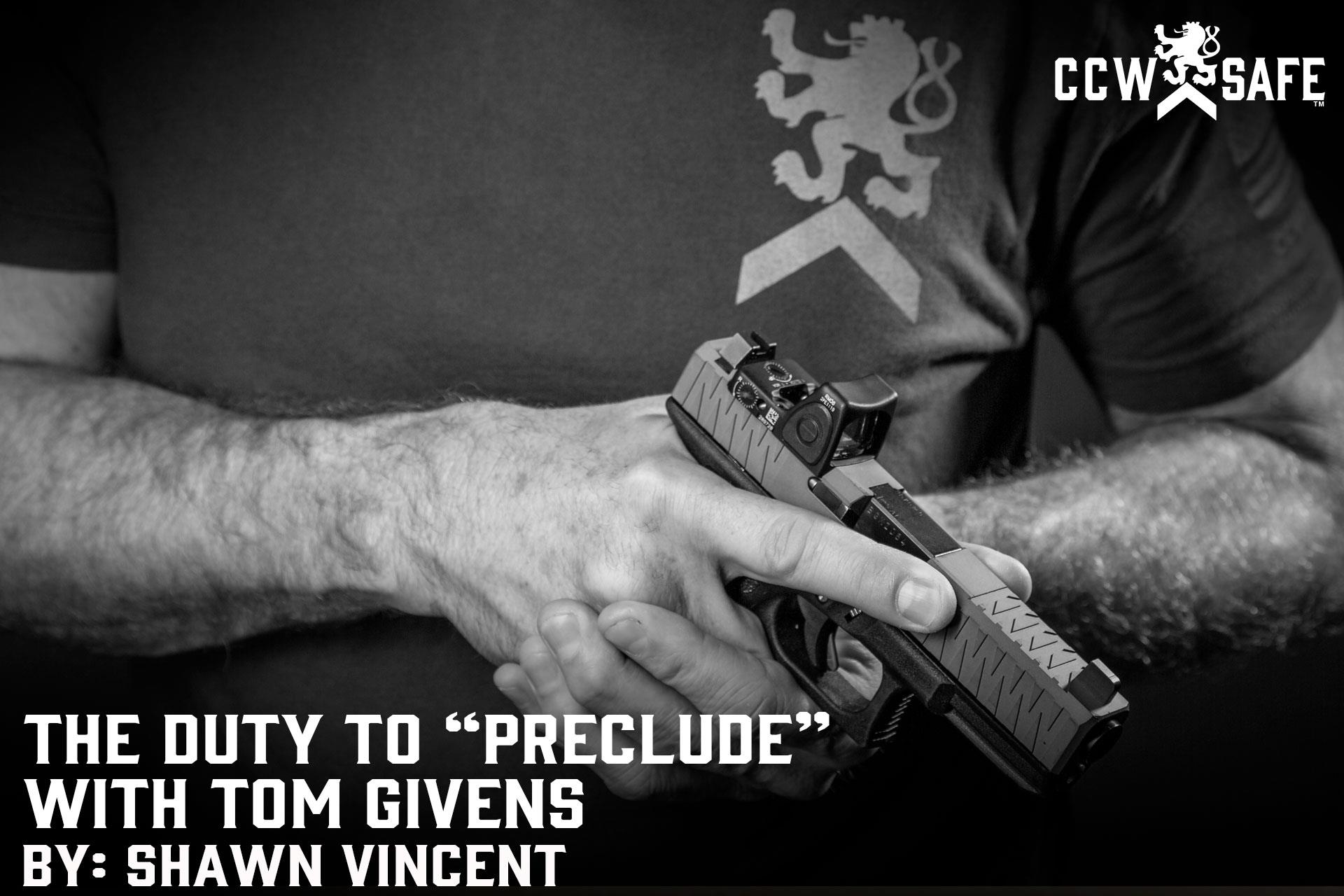
Posted on April 29, 2022
The Duty to Preclude
There’s something disagreeable about the word “retreat.” Soldiers in an army retreat when confronted with a superior force. They are running from a fight they can’t win. They’ve lost. What makes an armed defender different from a soldier in an army is that the armed defender isn’t trying to win a fight, they are trying to end a fight – or avoid a fight altogether. Many of the firearms instructors we’ve spoken with, from Chuck Haggard to Tom Givens, have told us that the goal of self-defense is to break contact, and when it can be done safely, “retreating,” for lack of a better word, is a perfectly acceptable way to break contact.
Tom Givens, founder of Tac-Con, actually does have a better word for “retreat.” Tom prefers to talk about “preclusion,” which is the act of preventing something from happening.
“I give people a double-your-money-back guarantee that you’re going to survive every single violent confrontation you don’t get in,” Tom says. Firearms instructor Steve Moses has frequently trained with Tom, and he agrees, “I think it is in the best interest of concealed carriers to avoid conflict and comport themselves in such a manner that they’re not chosen as victims. If, indeed, they think they might have been targeted, disengage immediately, if not, de-escalate, and then last, defend appropriately.”
Some states legally require armed defenders to attempt to disengage from a confrontation, and legislators have put the words “duty to retreat” right in the law. Other states have laws that specifically waive the duty to retreat, and many specifically grant armed defenders the right to “stand your ground.” Some states don’t specify either, and there is a complex history of case law that impacts which standard applies in a courtroom setting. Don West, criminal defense attorney and National Trial Counsel for CCW Safe, says that “Whether there’s a legal duty to retreat or a right to stand your ground with no legal duty to retreat, it is a legal issue, not a tactical one.”
Don explains that in duty-to-retreat states, prosecutors can argue that armed defenders are guilty if they didn’t take an opportunity to safely retreat; it’s another legal obstacle for a defender’s legal team to overcome in pursuit of an acquittal. In some states, where there are “hard stand-your-ground” laws, as attorney Andrew Branca refers to them, prosecutors are explicitly prohibited from suggesting that an armed defender’s failure to attempt retreat indicates guilt. Regardless of what a prosecutor is specifically allowed to argue, at the core of any self-defense case is the idea that the armed defender’s actions were reasonable. Even in the hardest of stand-your-ground states, if a jury is presented with evidence that an armed defender had a clear opportunity to safely withdraw from a potentially violent confrontation and chose to engage regardless, that jury may conclude the defender’s choice was not reasonable. If an armed defender is given the opportunity to fight or safely flee, and there is no one else in danger, the choice to stay and fight is a critical mistake. In such a case, Tom Given says, “You’re turning it into mutual combat rather than self-defense.”
Tom emphasizes that “Even in states that have “duty to retreat” in the statute, one of the things that so many people miss is it says, ‘if you can retreat in safety.’ You’re not required to back away from somebody that’s shooting at you . . . ‘Retreat’ doesn’t necessarily mean running away, it means breaking contact and disengaging from what is becoming a dangerous situation.” Tom is paraphrasing the spirit of the laws, and as a concealed carrier, you should be intimately familiar with the specific language of laws in your state and wherever you carry.
While stand-your-ground laws are great for removing statutory obstacles from an armed defender’s legal defense, they have the unfortunate side effect of confusing the issue of when deadly force is actually justified. Stand-your-ground does not grant a concealed carrier the right to engage in “mutual combat,” as Tom Givens notes. It is not intended to give an armed defender permission to act as a soldier to defend some arbitrary patch of dirt (in someplace other than his or her home).
The lesson for concealed carriers is that “stand your ground” is a legal concept designed to protect armed defenders from prosecutors who would twist the spirit of “duty-to-retreat” laws to win a conviction in an otherwise justifiable homicide case. From a tactical perspective, the duty to retreat is an important best practice for armed citizen defenders who understand that they win every gunfight they avoid. If you don’t like the term “duty to retreat,” then you can adopt the concept of “duty to preclude.” If you make preclusion your policy, should you ever face an imminent deadly threat that you are unable to avoid, then you can use deadly force to defend yourself with the confidence that you are more likely to be justified under any interpretation of the law.